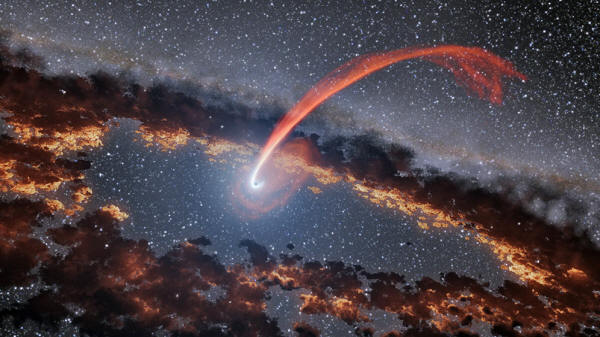|
by Davide Castelvecchi
Scientific simulation of a black hole consuming a neutron star. Credit: A. Tonita, L. Rezzolla, F. Pannarale
LIGO and Virgo observatories have spotted ripples from what could be the first-ever detection of this long-sought event...
If confirmed, it would be
the first evidence of the existence of such binary systems. The news
comes just a day after astronomers had detected gravitational waves
from a
merger of two neutron stars for
only the second time.
Astronomers are still
analyzing the data and doing computer simulations to interpret them.
Astronomers around the world are also racing to observe the phenomenon using different types of telescope.
But the signal was not very strong, which means that it could be a fluke.
LIGO and Virgo had previously caught gravitational waves - faint ripples in the fabric of space-time - from two types of cataclysmic event:
The latter are small but
ultra-dense objects formed after the collapse of stars more massive
than the Sun.
The researchers have drawn a 'sky map', showing where the gravitational waves are most likely to have originated, and sent this information out as a public alert, so that astronomers around the world could begin searching the sky for light from the event.
Matching gravitational
waves to other forms of radiation in this way can produce much more
information about the event than either type of data can alone.
Her team can commandeer robotic telescopes around the world.
In this case, the researchers immediately started up one in India, where it was night time when the gravitational waves arrived.
At 08:18:26 UTC on 25
April,
another train of waves hit the
LIGO's detector in Livingston, Louisiana, and Virgo. (At the time,
LIGO's second machine, in Hanford, Washington, was briefly out of
commission.)
Based on the waves'
loudness, the researchers also estimated that the collision occurred
some 150 megaparsecs (500 million light-years) away, says Hanna.
That was around three times farther than
the 2017 merger.
An artist’s rendition of a star throwing off a glowing stream of debris as it is disrupted by a supermassive black hole. Credit: NASA and JPL-Caltech
The alert of the 25 April event came at 5:01 a.m.
A storm of activity swept the meeting, with astronomers who would normally compete with each other exchanging information as they sat with their laptops around coffee tables.
But in this case, unlike many others, LIGO and Virgo were unable to significantly narrow down the direction in the sky that the waves came from.
The researchers could say
only that the signal was from a wide region that covers roughly
one-quarter of the sky. They narrowed down the region slightly the
day after.
In the 2017 neutron-star merger, the combination of observations in different wavelengths produced a stupendous amount of science.
Two seconds after the
event, an orbiting telescope had detected a burst of gamma rays -
presumably released when the merged star collapsed into a black
hole. And some 70 other observatories were busy for months, watching
the event unfold across the electromagnetic spectrum, from radio
waves to X-rays.
To begin with, it
confirms that these long-sought systems do exist, originating from
binary stars of very different masses.
For this reason,
Moreover, the gravitational waves and the companion observations from astronomers could reveal what happens in the final phases before the merger.
As tidal forces tear the neutron star apart, they could help astrophysicist solve a long-standing mystery:
The LIGO-Virgo collaboration began its current observing run on 1 April (2019), and had expected to see roughly one merger of black holes per week and one of neutron stars per month.
So far, those predictions have been met - the observatories have also seen several black-hole mergers this month.
|



